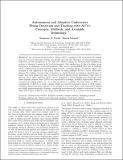| dc.contributor.author | Petillo, Stephanie Marie | |
| dc.contributor.author | Schmidt, Henrik | |
| dc.date.accessioned | 2018-04-23T17:13:40Z | |
| dc.date.available | 2018-04-23T17:13:40Z | |
| dc.date.issued | 2016-04 | |
| dc.identifier.issn | 1474-6670 | |
| dc.identifier.uri | http://hdl.handle.net/1721.1/114874 | |
| dc.description.abstract | An autonomous underwater vehicle (AUV) equipped with environmental sensors and an on-board autonomy system can greatly increase the efficiency of environmental data collection and the synopticity of the data set collected simply by autonomously adapting its motion to changes it senses in its local environment. One application of this is tracking ocean features in an unknown ocean environment. This can be accomplished with one or multiple AUVs collaborating in near-real-time using acoustic communications. To further explore one example of this application, this paper focuses on using multiple AUVs to track underwater plumes. We evaluate various types of plumes (e.g., hydrothermal vent plumes, algal blooms, oil leaks), how each plume type may be detected and its spatial extent determined, what types of sensors can be used, and how AUVs can be employed to autonomously and adaptively track these dynamic plumes. Since AUVs vary significantly in design, mobility, deployment duration, on-board processing power, etc., it is also necessary to consider the best choice of AUV (or combination of AUVs) to track a plume. Thus, an operator/scientist's choice of AUV type(s) will likely depend the type of plume to be tracked, or vice versa. Since most underwater plumes are highly spatiotemporally dynamic, employing environmentally adaptive autonomy to track them with a fleet of AUVs is one of the most efficient ways to do so, given today's technology. Keywords: Autonomous vehicles;
Adaptive systems; Marine systems; Sampling systems; Tracking applications; Marine environmental sampling; Underwater plumes | en_US |
| dc.publisher | Elsevier BV | en_US |
| dc.relation.isversionof | http://dx.doi.org/10.3182/20120919-3-IT-2046.00040 | en_US |
| dc.rights | Creative Commons Attribution-NonCommercial-NoDerivs License | en_US |
| dc.rights.uri | http://creativecommons.org/licenses/by-nc-nd/4.0/ | en_US |
| dc.source | Other repository | en_US |
| dc.title | Autonomous and Adaptive Underwater Plume Detection and Tracking with AUVs: Concepts, Methods, and Available Technology | en_US |
| dc.type | Article | en_US |
| dc.identifier.citation | Petillo, Stephanie M., and Henrik Schmidt. “Autonomous and Adaptive Underwater Plume Detection and Tracking with AUVs: Concepts, Methods, and Available Technology.” IFAC Proceedings Volumes 45, 27 (2012): 232–237 © IFAC | en_US |
| dc.contributor.department | Massachusetts Institute of Technology. Department of Mechanical Engineering | en_US |
| dc.contributor.department | Woods Hole Oceanographic Institution | en_US |
| dc.contributor.mitauthor | Petillo, Stephanie Marie | |
| dc.contributor.mitauthor | Schmidt, Henrik | |
| dc.relation.journal | IFAC Proceedings Volumes | en_US |
| dc.eprint.version | Author's final manuscript | en_US |
| dc.type.uri | http://purl.org/eprint/type/ConferencePaper | en_US |
| eprint.status | http://purl.org/eprint/status/NonPeerReviewed | en_US |
| dc.date.updated | 2018-04-20T11:20:36Z | |
| dspace.orderedauthors | Petillo, Stephanie M.; Schmidt, Henrik | en_US |
| dspace.embargo.terms | N | en_US |
| dc.identifier.orcid | https://orcid.org/0000-0002-2883-7027 | |
| dc.identifier.orcid | https://orcid.org/0000-0003-3422-8700 | |
| mit.license | PUBLISHER_CC | en_US |
